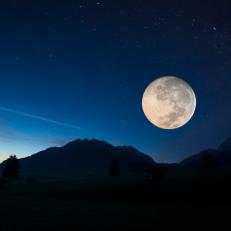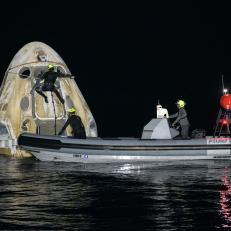View Planet Earth from Space
The world is a beautiful place. Celebrate our planet by seeing Earth from a new angle, from space!
Journey around our planet from a point of view, normally only seen by astronauts. Take a look at some of our favorite NASA images, taken from space, to learn more about our home planet.
From NASA: This image of our home planet shows how Earth looked from more than 950,000 miles, or 1.5 million kilometers, away during the total solar eclipse visible in Antarctica on Dec. 4, 2021. The EPIC instrument on the DSCOVR spacecraft captured the eclipse's umbra, the dark, inner shadow of planet Earth. Shaped like a cone extending into space, it has a circular cross section most easily seen during an eclipse.
From NASA: In this image taken on Oct. 30, 2021, an aurora dimly intersected with Earth's airglow as the International Space Station flew into an orbital sunrise 264 miles above the Pacific Ocean before crossing over Canada.
From NASA: As the International Space Station orbits the Earth, the crew makes observations of the universe and our home planet. This image taken from the space station shows the blue-green waters around the Bahamas, as shown in Space Station highlights for the week of Nov. 8, 2021.
From NASA: The Pilbara in northwestern Australia exposes some of the oldest rocks on Earth, over 3.6 billion years old. The iron-rich rocks formed before the presence of atmospheric oxygen, and life itself. Found upon these rocks are 3.45 billion-year-old fossil stromatolites, colonies of microbial cyanobacteria. The image, acquired in October 2004, is a composite of ASTER bands 4-2-1 displayed in RGB. With its 14 spectral bands from the visible to the thermal infrared wavelength region and its high spatial resolution of about 50 to 300 feet (15 to 90 meters), ASTER images Earth to map and monitor the changing surface of our planet and is one of five Earth-observing instruments launched Dec. 18, 1999, on the Terra satellite. The instrument was built by Japan's Ministry of Economy, Trade and Industry. A joint U.S./Japan science team is responsible for validation and calibration of the instrument and data products. The broad spectral coverage and high spectral resolution of ASTER provides scientists in numerous disciplines with critical information for surface mapping and monitoring of dynamic conditions and temporal change.
From NASA: On the northwestern coast of Madagascar, the salty waters of the Mozambique Channel penetrate inland to join with the freshwater outflow of the Betsiboka River, forming Bombetoka Bay. Numerous islands and sandbars have formed in the estuary from the large amount of sediment carried in by the Betsiboka River and have been shaped by the flow of the river and the push and pull of tides.
From NASA: Unlike some of its perpetually active neighbors on the Kamchatka Peninsula, Raikoke Volcano on the Kuril Islands rarely erupts. The small, oval-shaped island most recently exploded in 1924 and in 1778. The dormant period ended around 4:00 a.m. local time on June 22, 2019, when a vast plume of ash and volcanic gases shot up from its 700-meter-wide crater. Several satellites—as well as astronauts on the International Space Station—observed as a thick plume rose and then streamed east as it was pulled into the circulation of a storm in the North Pacific. On the morning of June 22, astronauts shot a photograph of the volcanic plume rising in a narrow column and then spreading out in a part of the plume known as the umbrella region. That is the area where the density of the plume and the surrounding air equalize and the plume stops rising. The ring of clouds at the base of the column appears to be water vapor. This photograph was taken with a Nikon D5 digital camera by a member of the Expedition 59 crew and is provided by the ISS Crew Earth Observations Facility and the Earth Science and Remote Sensing Unit, Johnson Space Center.
From NASA: Curling snow drifts are magnified by the terrain around the 1,400 mile Dnieper River, flowing from Russia to the Black Sea. European Space Agency astronaut Thomas Pesquet, a member of the Expedition 50 crew, captured this image from the International Space Station on "Feb. 9th, 2017, saying, "winter landscapes are also magical from the International Space Station: this river north of Kiev reminds me of a Hokusai painting." Each day, the International Space Station completes 16 orbits of our home planet as the crew conducts important science and research. Their work will not only benefit life here on Earth, but will help us venture deeper into space than ever before. Crew members on the space station photograph the Earth from their unique perspective, hovering 200 miles above us, documenting Earth from space. This record is crucial to how we see the planet changing over time, from human-caused changes like urban growth, to natural dynamic events such as hurricanes, and volcanic eruptions.
From NASA: The false-color image above shows the area of study along the Atchafalaya Delta. It was captured on December 1, 2016, by the Operational Land Imager (OLI) on Landsat 8. The colors emphasize the difference between land and water while allowing viewers to observe waterborne sediment, which is typically absent from false-color imagery.
From NASA: International Space Station Commander Alexander Gerst has a better view of our home planet than most. From aboard the orbital laboratory he sees Earth in all its beauty and said of this image of the west coast of southern Africa: "Not many artists in this world are as creative as Mother Nature."
From NASA: Regardless of the amount of winter ice cover, the waters off of the Alaskan coast usually come alive each spring with blooms of phytoplankton. These blooms can form striking patterns of blue and green seawater, such as those visible in this image of the Chukchi Sea acquired on June 18, 2018, by the Operational Land Imager (OLI) on Landsat 8. Blooms are a common occurrence this time of year. But the regularity of the blooms and their simple beauty belie the complexity of this ecosystem.
























